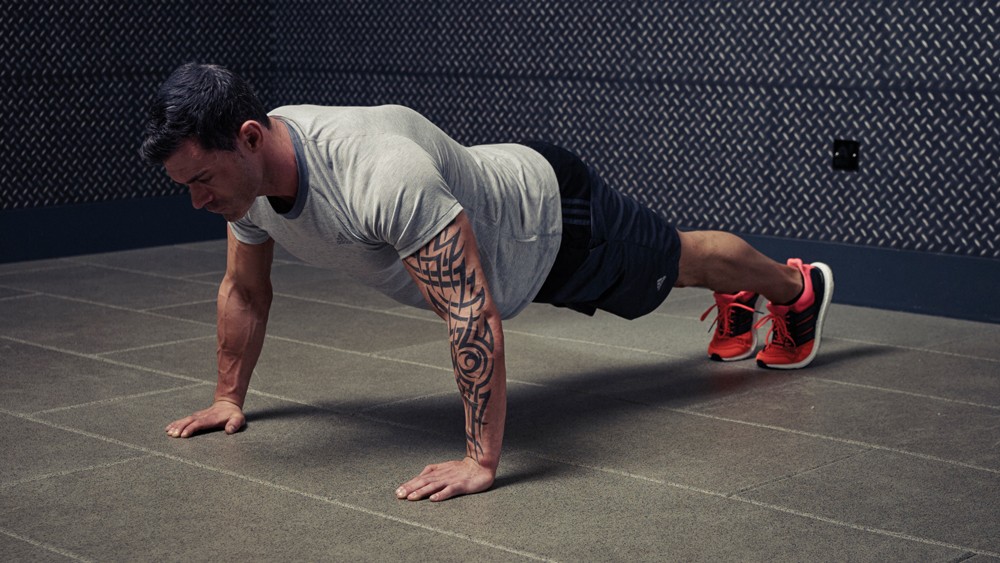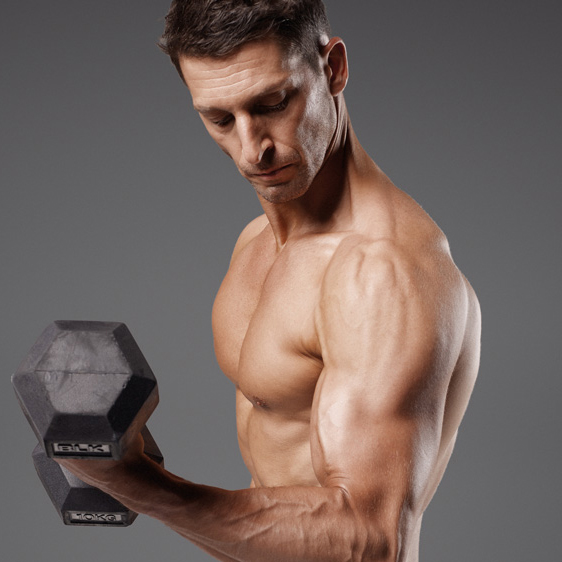Can You Build Muscle With Bodyweight Training?
Yes, up to a point. Find out when to use bodyweight moves to build muscle and the other benefits you don’t want to sleep on

If you want to pack on muscular size and strength, it can be tempting to head straight for the weights room and do compound lifts such as bench presses and back squats rather than press-ups, lunges and other bodyweight exercises. There’s a common assumption that bodyweight moves are too easy to be effective in building muscle, whereas heavy lifts break down the most fibres in your muscles, shocking them into growing back bigger and stronger.
While bodyweight training does have its limitations – it can’t effectively target your back and biceps, for instance – it offers many more benefits. These moves can reduce your risk of injury, are a perfect way to warm up and can actually improve your ability to go heavier when hitting the weights –plus you can do them anywhere, at any time. Here’s what you need to know to make bodyweight training work for you.
Beginners can build muscle with bodyweight training
Bodyweight moves are great for people who don’t have a gym membership or access to kit. They are especially beneficial to beginners, whose own weight is a sufficient stimulus to improve muscular size and strength.
“For muscle growth you need to perform three sets of eight to 10 reps at a weight that is around 75% of your one-rep max,” says personal trainer Darryl Edwards. “For beginners, their own weight provides the right level of resistance and poses less of an injury risk, unlike lifting weights which can be dangerous without correct form.”
Bodyweight training can also help injury-proof more advanced trainers. Because they are compound moves that involve more than one joint movement, these exercises recruit all your small, stabilising muscles. “Press-ups are great for improving the stability of the typically delicate shoulder joint,” adds Edwards.
Bodyweight training helps sportsmen builds power and muscular endurance
Ego prevents many gym-goers from doing bodyweight moves because they don’t get you the bragging rights a new bench press or deadlift one-rep max does. But if you are training to build muscular endurance as well as power, bodyweight training is ideal. That’s why combat athletes are some of its biggest advocates.
“It’s very popular with MMA fighters and boxers, because they need a combination of muscular endurance – from low-weight, high-rep training – and explosive power,” says personal trainer Gavin Walsh. “Plyometric exercises, such as clap press-ups and box jumps, are great for priming your fast-twitch muscle fibres, which are responsible for power. Fighters want strong, functional muscles, not bulky ones that affect flexibility.”
Get the Coach Newsletter
Sign up for workout ideas, training advice, reviews of the latest gear and more.
In fact, bodyweight training has “huge transferable benefits for all sports in which you need to move your body powerfully and efficiently”, according to Nick Mitchell, founder of Ultimate Performance. “Bodyweight moves are also great as a warm-up before bigger lifts, or during interval runs – sprint for 20m before doing press-ups or squats. And do them immediately after a set with weights to crank out a few more reps to really fatigue your muscles.”
Making bodyweight training a core part of your regime could even lead to lifting heavier weights. “If the supporting tissues of your joints are strong, you are more likely to be able to lift heavier loads when progressing to weights,” says Walsh. “Many people struggle when upping the weight not because the target muscle is weak, but because a stabilising muscle fails first.”
When to progress from bodyweight training to weights
Although bodyweight moves have plenty of benefits, for bigger and stronger muscles you need to lift weights. “Once your muscles can lift your own weight comfortably, you will stop making strength gains,” says Mitchell. “My rule is once you can do 20 controlled press-ups, you need to increase the load for increased strength.”
That’s not to say that a session doing bodyweight moves is an easy session. You can make most kit-free moves harder: for example, putting your feet on a chair increases the amount of weight your upper chest and shoulders must move during a press-up. You can also work your shoulders seriously hard by doing handstand press-ups, while single-leg pistols are far harder than standard squats. But they are still no substitute for heavy weights if you want to add size.
One big problem with bodyweight training is that it is impossible to effectively target your back and biceps. This, and the limitation on how much you can lift, makes kit-free moves unpopular with gym-goers who want to pack on size by isolating each muscle and developing it to its maximum potential.
“To develop a muscle fully you need to target your muscles from many angles and through their full range of motion, which is only possible with free weights, machines and other specialist kit,” says Mitchell.
How to use bodyweight moves to sculpt a six-pack
You may not think you do many bodyweight exercises, but most moves that target your core muscles are working only against gravity or your body’s own resistance. So are crunches, Russian twists and planks the best moves for carving a six-pack?
“You can do all the abs bodyweight moves in the world but the best way to build a strong core is to do big lifts such as squats, overhead presses and deadlifts,” says Nick Mitchell. “They force your core to work hard and are far more effective than knocking out hundreds of crunches.”
If you are weighing up whether to do bodyweight abs moves or heavy lifts, remember these approaches aren’t mutually exclusive.
“Nobody should give up any one move more than a carpenter should give up any one tool, because every exercise has its own benefits,” says trainer JC Santana, founder of the Institute for Human Performance in the US. “During a press-up your core is fully engaged to stabilise your torso. This doesn’t happen with the bench press.”
Darryl Edwards agrees. “Side planks, crunches and Russian twists hit your abs from every angle. You need to overload your muscles so they’re never comfortable. The best way is to hit them hard from as many angles as possible.”

Joe Warner is a highly experienced journalist and editor who began working in fitness media in 2008. He has featured on the cover of Men’s Fitness UK twice and has co-authored Amazon best-sellers including 12-Week Body Plan. He was the editor of Men’s Fitness UK magazine between 2016 and 2019, when that title shared a website with Coach.
